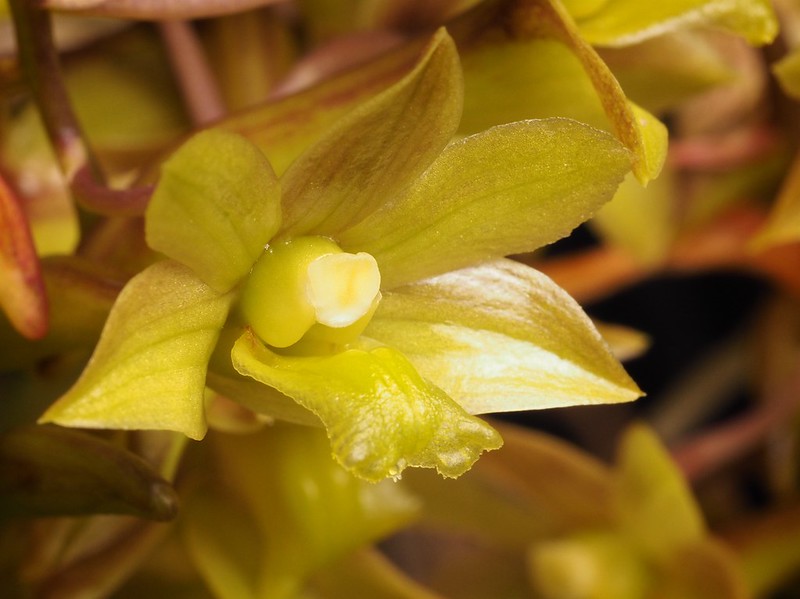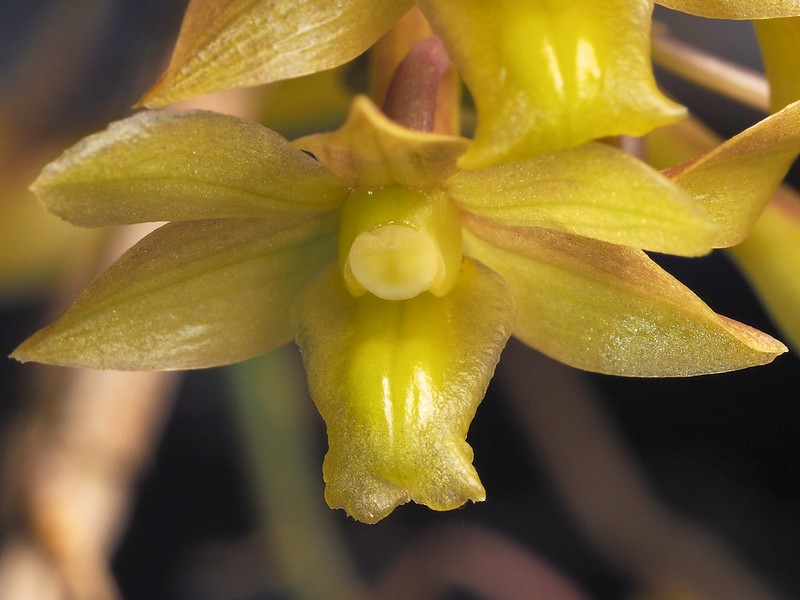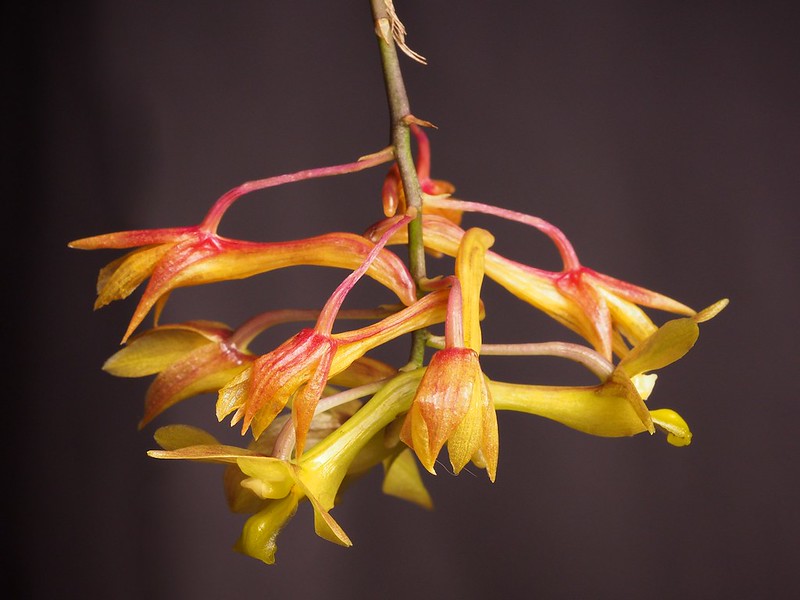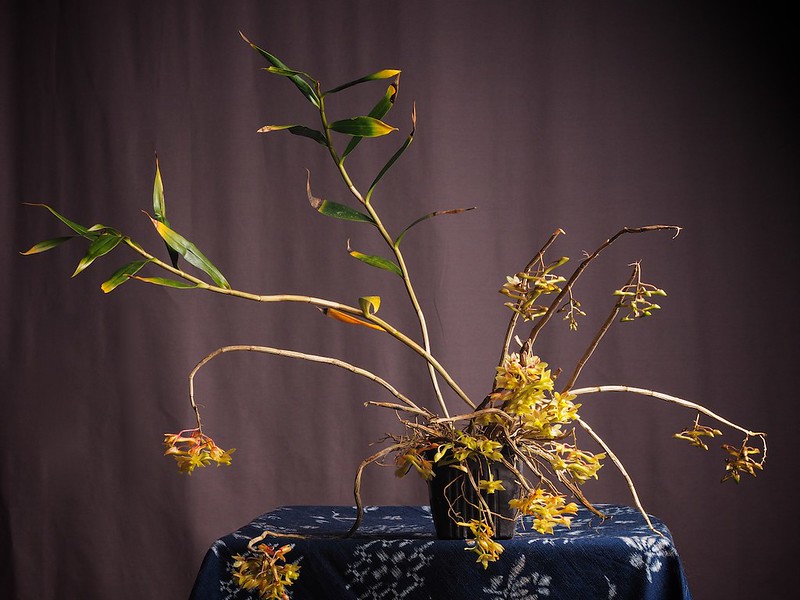
This was purchased as Dendrobium guerreroi, division of 'CC9607' from Troy Meyers (TN6874), but I'm guessing that this is actually D. ionopus. Troy, who is great at keeping records, told me that he purchased this plant from Tropical Orchid Farm in April 15 1996 (TOF's original tag: F2064 Dendrobium guerreroi x sib). It is great to keep the record straight; history of plants are lost most of the time since people don't keep good record! Thank you, Troy!
Indeed, The Dendrobium by H. P. Wood (p.645) mentions that some plants of D. ionopus imported from Philippines were incorrectly identified as D. guerreroi. Both of these species belong to Section Calcarifera, a section with 50-60 species. Species epithet of D. ionopus means "violet", which refers to the purple marking (dots) at the base of lip on flowers and the young leaves with purple stripes. Mine lacks this purple dots on the flower, and I haven't noticed purple stripes on the leaves. But in the description of D. epidendropsis (supposed to be synonymous to D. ionopus) in Orchidiana Philippiana (Vol. 1, p. 152), H. L. Valmayor doesn't mention purple leaves and her color illustration doesn't have purple dots. Her illustration is similar to mine. So I'm pretty convinced that my plant is D. ionopus (similar to Valmayor's D. epidendropsis, which is supposed to be a synonym of D. ionopus).
When I was looking into this group of species, I learned that photos of D. guerreroi are difficult to find. I found photos of D. guerreroi in books: The Dendrobium by H. P. Wood, Dendrobium and Its Relatives by B. Lavarack, W. Harris, G. Stokers, and The Orchids of the Philippines by J. Cootes. They are all from a single image taken by Jim Cootes, which is same as the one in IOSPE (the ones in Lavarack et al. and IOSPE have the right and left sides flipped). There are 6 photos from 4 different plants of D. guerreroi in Swiss Orchid Foundation at the Herbarium Jany Renz (search here). One determined by K. Senghas (photo 1, photo 2) has the jagged lip with a quite different shape from any others. 2 different plants determined by G. Meyer (plant 1, plant 2) looks very similar to mine. So these might be D. ionopus (similar to D. epidendropsis in Valmayor's book). Another plant with 2 photos (photo 1, photo 2), determined by R. Jenny, looks somewhat similar to mine, but the base of lip has two red dots, just like the typical D. ionopus. None of these look like the photo by Jim Cootes, and I'm guessing that the ones in Swiss Orchid Foundation are likely to be all misidentified. Additionally, I found these images, which are probably same as mine (D. ionopus). I may be completely wrong (please, please correct me if this is the case!), but there appears to be a wide-spread confusion about this group. I'd love to hear if you have an opinion!
Distributions: The Orchids of the Philippines by J. Cootes (p. 79-80) states that D. ionopus is from the mountains of Bataan, Benguet, Nueva Ecija, Nueva Vizcaya, Rizal provinces on Luzon at altitudes of about 1200m. Dendrobium and Its Relatives by B. Lavarack, W. Harris, G. Stokers gives similar information; this species is from 900m altitude in montane rainforests, and it is also supposed to be in Japan. On the other hand, D. guerreroi is uncommon in nature and from Dinagat Island and the province of Oriental Mindoro on the Mindoro island (Cootes, p.78), which is rather interesting discontiguous distribution.
According to Orchid Species Culture: Dendrobium by M. L. Baker and C. O. Baker, D. epidendropsis (information for D. ionopus is not included) experiences max/min temperature of 25-26/19C (76-78/65-66F) for the entire year. But in the winter, rain fall is low for 3-5 months.
As a side note, according to this old article, the species epithet 'epidendropsis' comes from the resemblance to Epidendrum umbellatum.


When the older flowers start to wilt, the color become red.


Here is the original description of D. ionopus:
The Gardener's Chronicle. Vol. 18 (New Sereis), No. 469, p. 808 December 23, 1882 (link to the original)
Dendrobium ionopus, n. sp. *
It is just incredible how so many fresh members of the section Pedilonum have been intoduced by the firm of Hugh Low & Co. Here is once more a new one with a curious mauve cluster of racemes, mauve stalked ovary, and exceedingly short bracts. The flowers are deep yellow, with a red hue along the thicker back of the falcate spur-like extension of the disc. There are two fine purple blotches on the base of the expanded three-lobed lacinia before the thick channelled stalk of the lip which bears a long depressed retrorse tooth. Finally the trifid border of the androclinium has four red blotches. The flowers are somewhat smaller than those of Dendrobium cumulatum. Mr. H. Low States nothing of the locality, which would appear to be Birmah. H. G. Rchb. f.
* Dendrobium ionopus, n. sp. --- (Pedilonum): racemis abbreviatis; bracteis minutis; sepalis triangulis, lateralibus in mentum falcatum elongatis; tepalis triangulis; labelli ungue elongato crasso canaliculato cum dente plano retrorso, lamina antica explanata triloba, lobis lateralibus obtusangulis lobo antico producto retuso emarginato; androclinio trifido. H. G. Rchb. f.
I have the same delema with my plant, purchased as D. guerreroi. I did find the Isotype of the Ames & Quir. collection in the New York Bot collection, as well as a second Isotype. Both look the same and I cannot see any difference to D. ionopus, as we generally purchase it. The white-flowered plant that Cootes ID as D. guerreroi is clearly not the same as in the Isotype. I don't know what he was thinking. Maybe he actually had a hands-on with one of these Isotypes? My plant, also, has a somewhat broader, more spade-shaped lip and is almost completely green. I can send over the shots, if you like.
ReplyDeleteThank you for the info! I would be interested in seeing th photos, so it would be great if you can send them to my email: ntakebayashi@alaska.edu. It is interesting that the isotypes of D. guerreroi look like D. ionopus. After you pointed it out, I looked up NYBG database, and saw the digital image of the isotope: (link), but it's difficult to tell for me. I wonder what is the real D. guerreroi (I'm trying to obtain the original description).
Delete